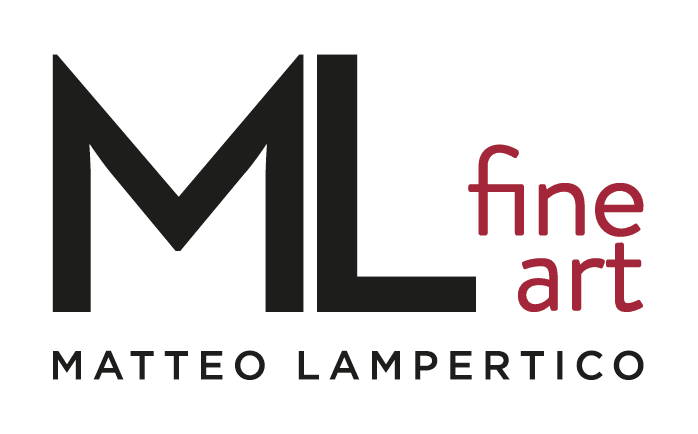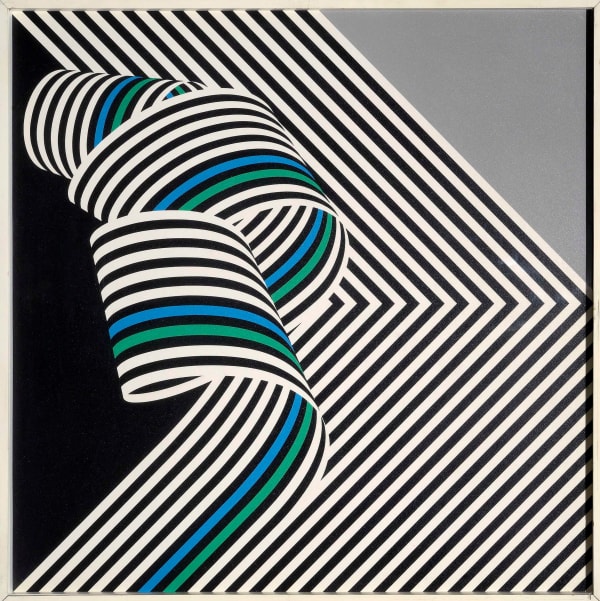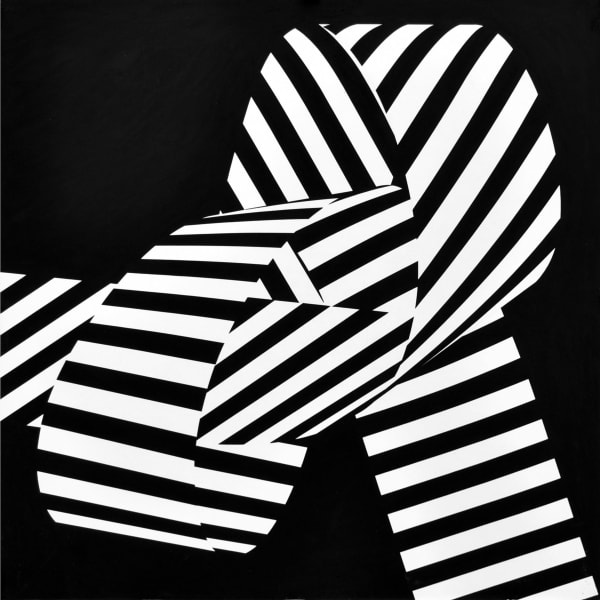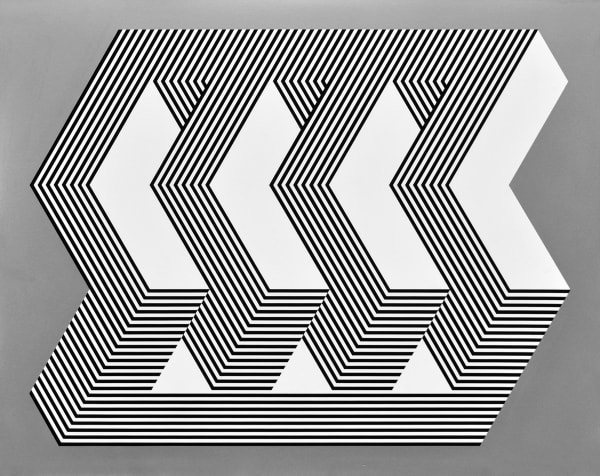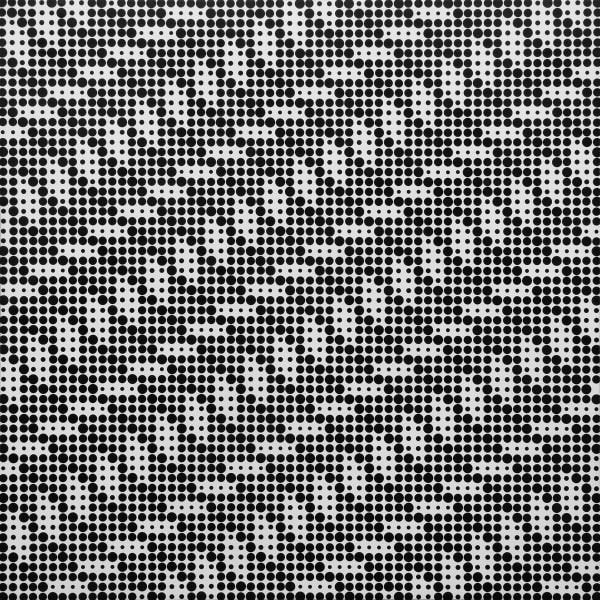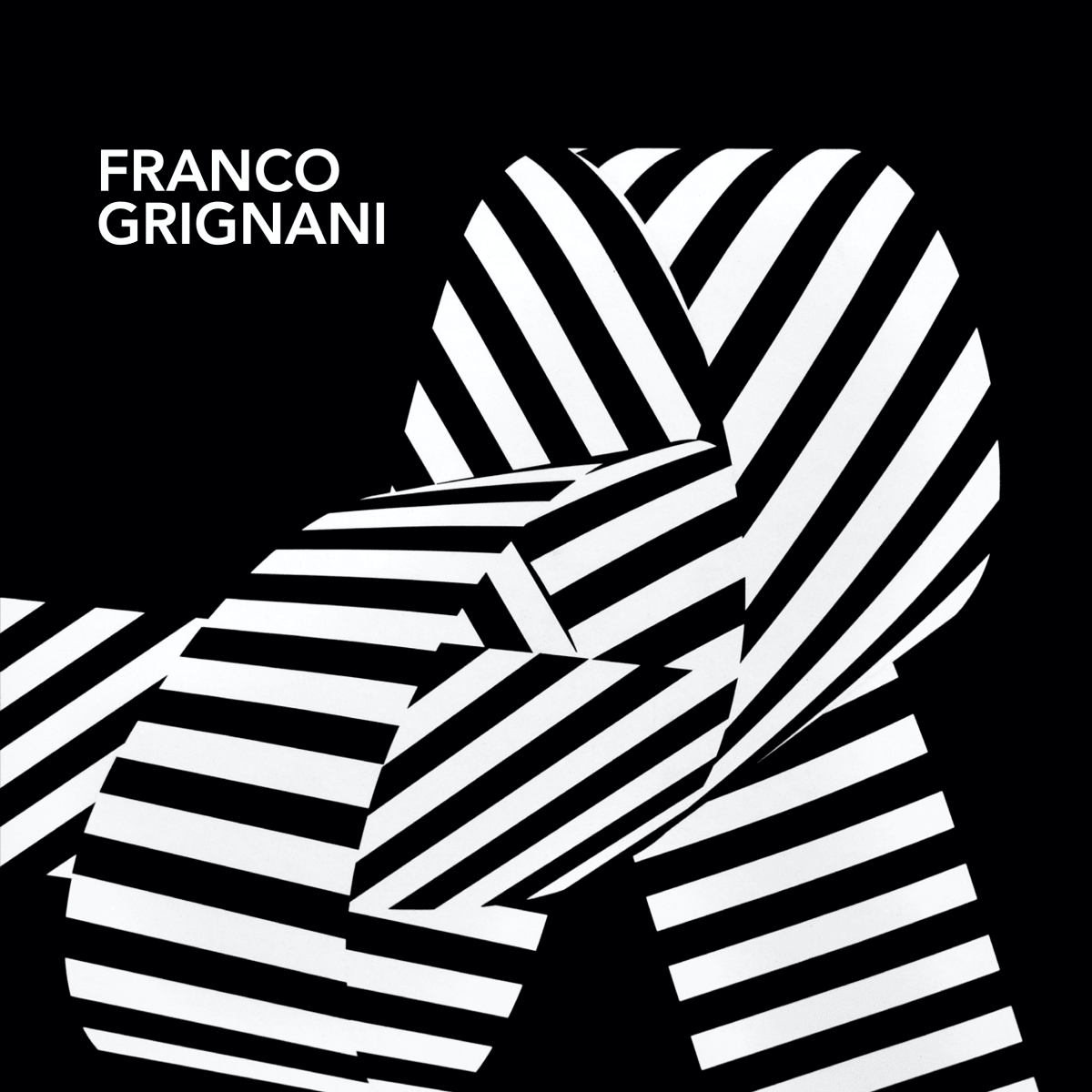Franco Grignani Italian, 1908-1999
After a period of Futurism-influenced training, from the 1950s Franco Grignani focused on the theme of visual perception, anticipating optical art research by nearly a decade and working in parallel with artists such as Victor Vasarely. In the first works of that decade, Grignani experimented with a new technique using industrial textured glass to achieve an effect of vibration, or photo emulsion transfers onto canvas.
From the end of the 1950 onwards, he used more traditional techniques, although his research on visual perception shows exemplary consistency and rigour. His work is contemporary with, if not preceding that of other optical art protagonists such as Bridget Riley, Francois Morellet, Walter Le Blanc, Jesus Raphael Soto, and Carlos Creuz-Diez, with whom he shared a scientific approach to artistic creation based on the principles of Gestalt psychology.
-
 Dissociazione al Centro n. 125
Dissociazione al Centro n. 125 -
 Congiunzioni evolutive, 1952
Congiunzioni evolutive, 1952 -
 Flou, 1955
Flou, 1955 -
 Combinatoria di strutture ondulate interferenti, 1956
Combinatoria di strutture ondulate interferenti, 1956 -
 Alternanza progressiva (n. 29/B), 1961
Alternanza progressiva (n. 29/B), 1961 -
 Dipinto n. 14 / A, 1962
Dipinto n. 14 / A, 1962 -
 Operativo numerico, 1962
Operativo numerico, 1962 -
 Permutazione plastica ondulata su 4 trame matematiche (58/A), 1962
Permutazione plastica ondulata su 4 trame matematiche (58/A), 1962 -
 Permutazioni oscillanti su reticolazione matematica (66/A), 1962
Permutazioni oscillanti su reticolazione matematica (66/A), 1962 -
 Tensione plurima 228, 1964
Tensione plurima 228, 1964 -
 Deriva, 1967
Deriva, 1967 -
 Dissociazione al bordo (n. 145), 1967
Dissociazione al bordo (n. 145), 1967 -
 Dissociazione dal bordo, 1969
Dissociazione dal bordo, 1969 -
 Dissociazione dal bordo, n. 308, 1970
Dissociazione dal bordo, n. 308, 1970 -
 Dissociazione proiettiva dal campo (n. 333), 1970
Dissociazione proiettiva dal campo (n. 333), 1970 -
 Psicoplastica n. 362, 1970
Psicoplastica n. 362, 1970 -
 Psicoplastica n. 414, 1971
Psicoplastica n. 414, 1971 -
 Psicoplastica n.455, 1972
Psicoplastica n.455, 1972 -
 Campo lineare oscillante, 1975
Campo lineare oscillante, 1975 -
 Campo reticolare , 1975
Campo reticolare , 1975 -
 Campo reticolare DN / 919, 1975
Campo reticolare DN / 919, 1975 -
 Campo reticolare DN 919, 1975
Campo reticolare DN 919, 1975
-

Esprit de géométrie
25 Maggio - 23 Luglio 2021ML Fine Art is pleased to announce the upcoming exhibition Esprit de géométrie, from May 25 to July 23 2021, in via Montebello 30, Milan. The show explores the connection...Maggiori informazioni -

Franco Grignani
1 Giugno - 28 Luglio 2017Featuring around 20 paintings from the 1950s through to the 1970s, the current exhibition provides a survey of artist and master of Italian post-war graphic design Franco Grignani with peculiar attention dedicated to works showcasing his stylistic developments during this period.Maggiori informazioni
Franco Grignani travelled through the whole length of the Twentieth century. The Italian artist was born in Pieve Porto Morone on 4 February 1908. He experienced and participated in all those art movements that took place in his country throughout the century: the second period of Futurism followed by geometric Abstract art and, after the Second world war (where Grignani was mobilised as an Officer in the Italian army), he turned to the applied arts and typography to which he dedicated himself entirely by focusing intensely on pictorial experimentation. These two latter activities were initially complimentary to his other work yet during the 1960’s Grignani became the forerunner of Kinetic art and grew close to the main players in the New Tendency movement as well as being the creator in 1964 of one of the twentieth-century’s most famous logos, the one created for woolmark.
Franco Grignani was active throughout his entire life and was consistently in search of new visual expressions. He regularly exhibited his works in the most renowned galleries in the north of Italy and became famous on an inter- national level on account of his work as a graphic designer. Nevertheless, his fame as a painter of paintings never left the confines of Milan so it is time now for a reflection on this part of his curve. Franco Grignani started off on an artistic path from the very beginning of his career. At the same time, he was pursuing his studies in architecture in Turin, he started to draw and paint in a Futurist style that was marked, in particular, by the machine-oriented shapes and forms of Fortunato Depero and the spasmodic style of Vorticism. In 1933, he was accepted as a participant in an exhibition organised in Rome under the aegis of Marinetti, entitled the Grande Mostra nazionale futurista. He soon settled down in Milan and in his paintings he began to employ – from 1935 onwards – the language of Abstraction as witnessed in his geometrical compositions and in the paintings of Mauro Reggiani, Manlio Rho and the members of the Como Group. Such an artistic evolution underlined the artist’s audacity as well as his independence in a country that had only just turned towards Abstract art forms and where, it must now be remembered, Mussolini’s dictatorship was holding sway.
From his artistic beginnings, Grignani showed himself to be both logical and confident in his approach. He nevertheless did not take part in the foundation of the various art groups that occurred after the war: for example, the Movimento d’Arte Concreta (MAC), Forma I or Origine. It was in such art groups that the most famous Italian Abstract painters of the second half of the Twentieth century created their own special œuvres. His own artistic interests jolted him along a sort of parallel path upon which he gave rein to his creativity and upon which he used the experience he had accrued. He was necessarily thorough and his work in graphic design and publicity took up all his time transforming him into a maestro in this particular field.
Franco Grignani enjoyed a primary role alongside Max Huber, Bruno Munari and Giovanni Pintori who were responsible for publicity for Olivetti and he joined the Alliance graphique internationale (AGi). In terms of style, his work was in line with the work of the Swiss graphic designers, Max Bill, Richard-Paul Lohse, Herbert Matter and Hans Neuburg who, towards the close of the 1940s, inherited the legacy of theconstructivist typographical design that hadburgeoned in the two previous decades.
Starting off from these new directions, from the middle of the 1950’s and throughout the two following decades, Grignani methodically established a repertoire of forms and of combinations that he grouped according to subjects and that he realised in systematic series with no other intention apart from continually referring to structure and addressing perception. In Grignani’s art, there was no place either for inspiration or for any sort of sensitivity. All that mattered was form and geometry. His vocabulary was made up of lines, parallel strips, units and black and white. His subject matter was made up of outline, depth, movement and stability as well as positive and negative elements and chiaroscuro. His rules were orthogonal structure and his grammar was repetition, progression, superimposition, permutation, interference, a moiré effect and boundlessness. His means were calculation, exactitude, mastery of technique and perfection of the final effect. His final results were rhythm, saturation, flickering, instability, deformation, ambiguity, illusion, lack of clarity, disorder and chaos.
From 1960 onwards, Franco Grignani exhibited his works in the most renowned galleries in the North of Italy and a whole host of public institutions as often as he could. He exhibited at the art gallery L’Elefante in Venice and, in 1966, at the il Cenobio art gallery in Milan. He exhibited in 1970 at Bergamo’s Lorenzelli gallery and during the following year he was present at the San Fedele gallery. In Reggio Emilia he exhibited at the city council in 1979 in a retrospective. A retrospective was also held for him in 1965 in Chicago, followed in 1968 by a similar one in Stuttgart. Italy most important art critics recognised the worth of his artistic production and included the likes of Guido Ballo, Umbro Apollonio, Giulio-Carlo Argan, Germano Celant, Gillo Dorfles and Lara Vinca Masini.
From the middle of the 1950s, Grignani positioned each of his paintings inside regular orthogonal grids, often strengthening and reinforcing his approach or disrupting the grids by introducing variations. With his uniform grid which takes up the whole painting and which carries on in a virtual fashion beyond the painting, Grignani started using, from 1955 onwards, regular outlines which were able to translate the principle of the abandonment of the composition as well as the disappearance of the center and any sort of pattern. His painting, Interferenze lineari del campo from 1974 is an illustration of this concept of painting which he shared with many other young abstract artists of the period who were associated, to various degrees, with the German Zero Group and the Dutch Nul Group (that were exhibited at Milan’s Azimuth gallery or in the exhibition Antipeinture in Ghent). These artists played a role in the beginnings of Kinetic Art and, by 1961, were all brought together in the exhibition entitled, Nouvelles Tendances, in Zagreb. François Morellet was the most illustrious representative of this family that included Franco Grignani who would have felt in time the full weight of such a firm artistic commitment18, as shown in the unity and the neutrality of his painting, 3 simples trames 0°-22°5-65° from 1960.
Franco Grignani played with depth by still managing to stay in within the work. He strove to create deformations in his work that would result in ondulations. By bringing together curved and counter-curved lines and by accelerating their movements, the artist created virtual pleats that awarded the work an impression of movement. His painting, Trauma fluttuante from 1965 is characteristic of his search for the disruptive effects that were manifest in Kinetic Art; a further example of this is Bridget Riley’s painting, Fall from 1963 (London, the Tate Gallery).
Franco Grignani died on 22 February 1999 in Milan, at the age of 91.
-

Frieze New York
3 - 6 Maggio 2018Franco Grignani (1908-1999) is one of the most respected artists in the Italian post-war art scene. A well-known graphic designer and designer (among other things,...Maggiori informazioni -

TEFAF Maastricht 2018
8 - 18 Marzo 2018M&L Fine Art is pleased to announce its inaugural participation at TEFAF Maastricht. Our booth will present a curated selection of Italian and international post-war...Maggiori informazioni -

Masterpiece London 2017
29 Giugno - 5 Luglio 2017Maggiori informazioni
